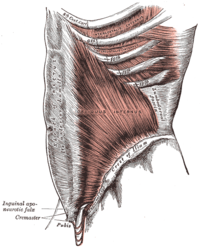
Photo from wikipedia
Pelvic organ prolapse (POP) is a common disorder in women. It is characterized by the descent of the vaginal wall with consequent drop of pelvic organs. Pregnancy, labour and childbirth… Click to show full abstract
Pelvic organ prolapse (POP) is a common disorder in women. It is characterized by the descent of the vaginal wall with consequent drop of pelvic organs. Pregnancy, labour and childbirth seem to be important events leading to the development of POP, since they are associated with prolonged stretch and mechanical stress of muscles, ligaments and connective tissue supporting pelvic organs. In pubocervical fascia, we explored the expression level of extracellular matrix and adhesion molecules. Tissue samples were obtained from twenty patients with POP who underwent cystocele repair, and from twenty control subjects during hysterectomy surgery. The PCR array analysis was performed and data were confirmed by Real-Time PCR and Western Blot. Real-Time PCR results showed a significant upregulation for extracellular matrix protein 1 (ECM1) and integrin beta 3 (ITGB3) and a significant downregulation for FBLN5 in POP group. The decreased mRNA expression of FBLN5 in pathological samples was paralleled by a quantitative decrease in the corresponding protein, as Western Blot test highlighted. Our data provide an understanding of molecular mechanisms involved in POP-related pathophysiological processes and might represent an important tool to develop novel therapeutic agents for the treatment of this condition.
Journal Title: Cellular and molecular biology
Year Published: 2018
Link to full text (if available)
Share on Social Media: Sign Up to like & get
recommendations!